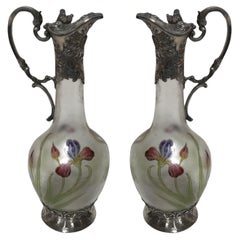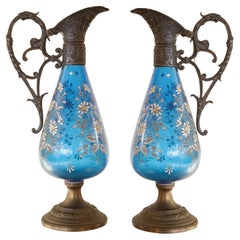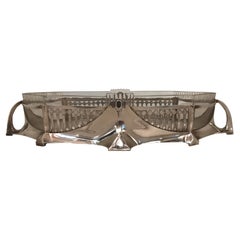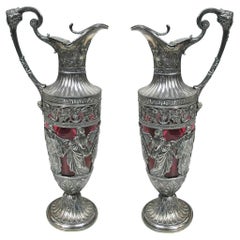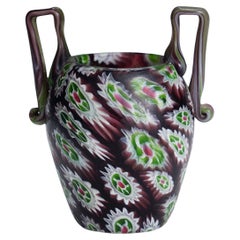Olivia Bee
Antique Early 1900s German Art Nouveau Pitchers
Art Glass
Antique Early 1900s German Art Nouveau Pitchers
Crystal
Antique Early 1900s German Art Nouveau Pitchers
Crystal, Enamel
Antique Early 1900s German Jugendstil Pitchers
Crystal, Enamel
Vintage 1910s German Art Nouveau Centerpieces
Crystal, Metal
Antique Early 1900s German Art Nouveau Pitchers
Art Glass
People Also Browsed
Early 20th Century Italian Mid-Century Modern Vases
Art Glass, Murano Glass, Murrine
Early 20th Century Austrian Bohemian Tableware
Bronze
Antique Late 19th Century Italian Victorian Vases
Gold Leaf
Vintage 1970s Italian Sterling Silver
Crystal, Sterling Silver
Antique Late 19th Century English Neoclassical Vases
Stoneware
Antique 19th Century French Empire Porcelain
Porcelain, Paint
Antique 17th Century British Sterling Silver
Silver
Vintage 1920s Italian Other Vases
Glass
Early 20th Century German Art Nouveau Sheffield and Silverplate
Metal, Silver Plate
Vintage 1920s German Art Deco Table Lamps
Bronze, Silver Plate
Antique 19th Century Italian Arts and Crafts Vases
Pottery
Early 20th Century Italian Art Nouveau Vases
Glass, Murrine, Murano Glass, Blown Glass, Art Glass
Antique Early 1900s Italian Art Nouveau Vases
Murano Glass
Antique 19th Century Italian Porcelain
Porcelain
Antique 1890s Italian Mid-Century Modern Vases
Brass, Metal, Copper
Antique Early 1900s German Art Nouveau Pitchers
Metal
WMF Württembergische Metallwarenfabrik for sale on 1stDibs
The fine brass, copper and silver metalware produced by distinguished manufacturer Württembergische Metallwarenfabrik (WMF) has adorned the tabletops of restaurants, hotels and homes around the world. WMF is especially prized by collectors for its Art Nouveau works of the late 19th century and Art Deco pieces manufactured throughout the early 20th century.
WMF traces its beginnings to 1880 when the merger of Straub & Sohn and Ritter & Co. formed the public limited company Württembergische Metallwarenfabrik. The company initially focused on tableware and decorative pieces, such as vases and planters. In 1892, WMF introduced its patented “perfect hard silver plating,” a technology that distributes twice as much silver to the sections of cutlery that experience the most wear, allowing the whole piece to hold its luster longer than other silver-plated products.
In 1905, WMF acquired a majority holding of Orivit AG, a company in Cologne that manufactured products from a tin alloy, further expanding its range of materials. By 1910, its main facility in Geislingen, Germany, employed 4,000 workers. It had branches in Vienna, Warsaw and London, and printed a catalog in 12 languages.
As a German business, WMF experienced extensive asset loss in the aftermath of the world wars. However, by 1950, its main facility once again had a workforce of more than 3,000 employees, and its high-quality products returned to popularity. There was an increase in demand for its Cromargan cutlery as well as work by WMF’s preeminent lighting designer, Wilhelm Wagenfeld.
By the 1960s, WMF’s main facility had 5,800 employees. More factories were opened to keep up with demand. WMF is now one of the largest manufacturers of metalware in the world and continues to produce pieces of superb quality. The company has over 200 branches in Germany, Austria and Switzerland, and owns branches in 40 other countries.
On 1stDibs, explore serveware, decorative objects, lighting and more from Württembergische Metallwarenfabrik (WMF).
A Close Look at art-nouveau Furniture
In its sinuous lines and flamboyant curves inspired by the natural world, antique Art Nouveau furniture reflects a desire for freedom from the stuffy social and artistic strictures of the Victorian era. The Art Nouveau movement developed in the decorative arts in France and Britain in the early 1880s and quickly became a dominant aesthetic style in Western Europe and the United States.
ORIGINS OF ART NOUVEAU FURNITURE DESIGN
- Emerged during the late 19th century
- Popularity of this modernizing style declined in the early 20th century
- Originated in France and Britain but variants materialized elsewhere
- Informed by Rococo, Pre-Raphaelite art, Japanese art (and Japonisme), Arts and Crafts; influenced modernism, Bauhaus
CHARACTERISTICS OF ART NOUVEAU FURNITURE DESIGN
- Sinuous, organic and flowing lines
- Forms that mimic flowers and plant life
- Decorative inlays and ornate carvings of natural-world motifs such as insects and animals
- Use of hardwoods such as oak, mahogany and rosewood
ART NOUVEAU FURNITURE DESIGNERS TO KNOW
ANTIQUE ART NOUVEAU FURNITURE ON 1STDIBS
Art Nouveau — which spanned furniture, architecture, jewelry and graphic design — can be easily identified by its lush, flowing forms suggested by flowers and plants, as well as the lissome tendrils of sea life. Although Art Deco and Art Nouveau were both in the forefront of turn-of-the-20th-century design, they are very different styles — Art Deco is marked by bold, geometric shapes while Art Nouveau incorporates dreamlike, floral motifs. The latter’s signature motif is the "whiplash" curve — a deep, narrow, dynamic parabola that appears as an element in everything from chair arms to cabinetry and mirror frames.
The visual vocabulary of Art Nouveau was particularly influenced by the soft colors and abstract images of nature seen in Japanese art prints, which arrived in large numbers in the West after open trade was forced upon Japan in the 1860s. Impressionist artists were moved by the artistic tradition of Japanese woodblock printmaking, and Japonisme — a term used to describe the appetite for Japanese art and culture in Europe at the time — greatly informed Art Nouveau.
The Art Nouveau style quickly reached a wide audience in Europe via advertising posters, book covers, illustrations and other work by such artists as Aubrey Beardsley, Henri de Toulouse-Lautrec and Alphonse Mucha. While all Art Nouveau designs share common formal elements, different countries and regions produced their own variants.
In Scotland, the architect Charles Rennie Mackintosh developed a singular, restrained look based on scale rather than ornament; a style best known from his narrow chairs with exceedingly tall backs, designed for Glasgow tea rooms. Meanwhile in France, Hector Guimard — whose iconic 1896 entry arches for the Paris Metro are still in use — and Louis Majorelle produced chairs, desks, bed frames and cabinets with sweeping lines and rich veneers.
The Art Nouveau movement was known as Jugendstil ("Youth Style") in Germany, and in Austria the designers of the Vienna Secession group — notably Koloman Moser, Josef Hoffmann and Joseph Maria Olbrich — produced a relatively austere iteration of the Art Nouveau style, which mixed curving and geometric elements.
Art Nouveau revitalized all of the applied arts. Ceramists such as Ernest Chaplet and Edmond Lachenal created new forms covered in novel and rediscovered glazes that produced thick, foam-like finishes. Bold vases, bowls and lighting designs in acid-etched and marquetry cameo glass by Émile Gallé and the Daum Freres appeared in France, while in New York the glass workshop-cum-laboratory of Louis Comfort Tiffany — the core of what eventually became a multimedia decorative-arts manufactory called Tiffany Studios — brought out buoyant pieces in opalescent favrile glass.
Jewelry design was revolutionized, as settings, for the first time, were emphasized as much as, or more than, gemstones. A favorite Art Nouveau jewelry motif was insects (think of Tiffany, in his famed Dragonflies glass lampshade).
Like a mayfly, Art Nouveau was short-lived. The sensuous, languorous style fell out of favor early in the 20th century, deemed perhaps too light and insubstantial for European tastes in the aftermath of World War I. But as the designs on 1stDibs demonstrate, Art Nouveau retains its power to fascinate and seduce.
There are ways to tastefully integrate a touch of Art Nouveau into even the most modern interior — browse an extraordinary collection of original antique Art Nouveau furniture on 1stDibs, which includes decorative objects, seating, tables, garden elements and more.
Finding the Right pitchers for You
Perfect for entertaining, a dinner party or a small luncheon, vintage, new and antique pitchers are versatile pieces to keep in any collection.
Whether you’re dining in the great outdoors, freshening up drinks in the living room or making a batch of fresh-squeezed juice for breakfast in the kitchen, a pitcher is a must-have feature of your dining and entertaining set.
Prior to indoor plumbing and the advent of sinks, people paired a pitcher with a wash basin on their bedside stand. Today, an antique washstand might be used as a nightstand or bedside table. These pitchers, along with the washstand, were essential in any bedroom.
Today, in displaying vintage ceramic pitchers on your Welsh kitchen dresser or in a corner cupboard, you’re inviting a pop of color and an alluring texture to mingle with your other serveware. But when entertaining, you’re likely going to put this decorative vessel to work. Some glazed stoneware and metal pitchers are outfitted with hinged lids to provide insulation, while potters and other craft artists at the time might have made complementary glasses or teacups to pair with their pitchers for a complete serving set. Glass and stoneware pitchers are perfect for serving beverages, but if you’re serving from a metal pitcher, you’ll want to ensure that the material is food-grade stainless steel.
For a simple home accent, consider using that wonderfully aging vintage metal pitcher as a vase for your flowers (be sure to use a watertight plastic liner or insert) or as a receptacle to display and organize your cooking utensils. Given the venturesome design sensibility that we associate with mid-century modernism, a mid-century modern pitcher is going to prove a unique and sophisticated decorative touch to any room in your home. While your farmhouse-style interior is practically begging for the earthy tones of a terracotta pitcher, an ironstone pitcher will bring ornate details to your mantel.
Find a collection of new, vintage and antique pitchers today on 1stDibs.


